

Autonomous Emergency Braking (AEB) is a vehicle safety and warning system, which employs sensors (such as radars and cameras) to detect possible collisions and automatically apply brakes in order to prevent accidents. Car Manufacturers favour it for its capability to alert the driver as well. If the system detects something, a forward collision warning is issued and, if the driver fails to take an action, automated emergency braking is activated to avoid collisions. AEB technology, hence plays an important role as a convenience feature than a safety feature as well.
Autonomous Emergency Braking- AEB systems typically work across a wider speed range. Depending upon the type of system, AEB systems use different sensors or cameras. Here is a gist about few of them
Sensors and Components Involved:
AEB utilises various sensors such as LIDAR, radars and camera, in order to monitor vehicle surroundings.
These sensors constantly scan the road, detecting objects, vehicles, or pedestrians.
Detection of Potential Collisions:
It assesses the distance and speed of nearby and incoming objects, via continuous monitoring.
It calculates the risk of a collision by analysing the relative speed and trajectory of the vehicle and potential obstacles.
Activation and Intervention Process:
AEB uses visual and audible alerts as indicators.
If the driver doesn’t respond, the system can also trigger an automatic braking system to avoid the collision.
AEB's seamless operation involves a network of sensors that identify potential dangers and, if necessary, intervenes promptly to enhance vehicle safety.
Also Read:- Types of Chassis Car
There are different kinds of AEB
City AEB vs. Highway AEB:
City AEB: Designed for urban driving scenarios, It focuses on low-speed environments due to traffic, crowd, frequent stops and starts due to bad roads even. AEB with pedestrian detection and better manoeuvrability in tight spaces are common nowadays, not only in luxury cars, but also in mid-ranged vehicles as well.
Highway AEB: Tailored for higher speeds encountered on highways or freeways, this system emphasises long-range detection and can respond effectively to fast-moving traffic, often prioritising vehicle-to-vehicle collision avoidance.
Single Sensor vs. Multi-Sensor Systems:
Single Sensor AEB: Utilises a singular sensor, typically radar or camera-based, for collision detection and intervention, suitable for simpler applications and cost-effective solutions.
Multi-Sensor AEB: Integrates various sensors (radar, cameras, LIDAR) to gather comprehensive data, providing more accurate and reliable collision detection, often employed in advanced safety packages for enhanced safety coverage.
Also Read:- Best Car for Long Distance Trip
Statistics on Reduced Collision Rates:
Studies indicate a significant decrease in rear-end collisions due to AEB implementation, showcasing up to a 50% reduction in accidents.
Research from safety authorities highlights a notable decline in collision frequency and severity when AEB is installed.
Real-life Scenarios Demonstrating AEB Effectiveness:
Various documented incidents and crash simulations illustrate AEB systems successfully averting collisions in urban settings, highways, and congested traffic conditions.
Testimonials and reports from drivers recount situations where AEB prevented accidents or lessened their impact, endorsing its efficacy in diverse real-world scenarios.
Also Read:- Family Cars in India
Some of the key benefits of using this safety feature in cars include:
AEB heightens safety by automatically applying brakes to prevent collisions or mitigate their severity.
Statistics show a substantial decline in accidents and resultant injuries due to AEB's intervention.
Drivers often receive insurance discounts, promoting AEB adoption and reducing overall costs. D. Potential Societal Impact:
AEB adoption contributes to broader road safety initiatives, potentially decreasing accidents on a societal level.
Also Read:- Types of Car Engines
As it is said, with great power comes great concerns. There are some limitations to the system and continuous efforts are being made to solve each of them. Some of the challenges that lie ahead include:
Environmental Factors:Extreme weather conditions can affect AEB performance, reducing accuracy in certain situations.
System Limitations: AEB might generate false positives or negatives, impacting its reliability and trustworthiness
Technological Constraints: Continuous technological advancements are required to refine AEB's precision and overcome limitations for enhanced safety.
In conclusion, the new cars with AEB are ensuring that the security is paramount. The AEB monitors car control, and adds features like lane departure warning etc. The AEB systems can work to avoid collisions by automatically applying a braking system to decelerate in case of emergency. As AEB continues to evolve, it will eventually be for the greater good and safer rides.